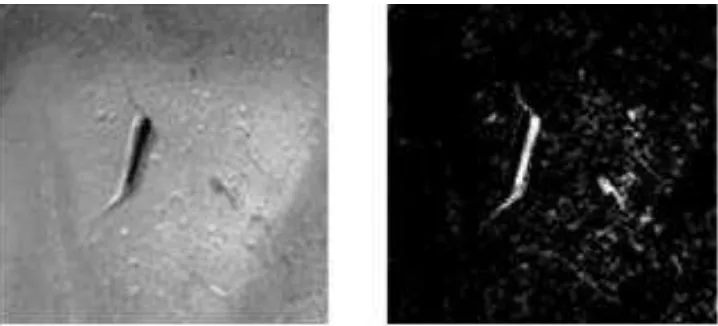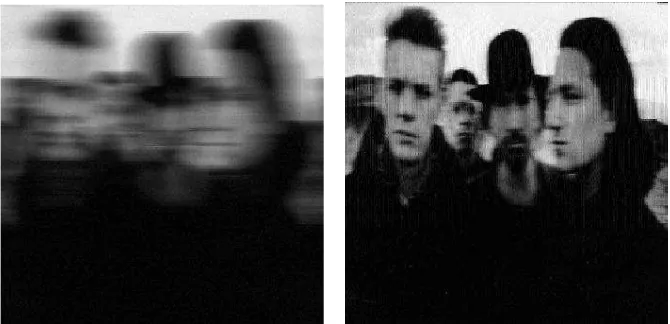UNIVERSITI TEKNIKAL MALAYSIA MELAKA
DEFECT DETECTION ON THE METAL SURFACE BY USING
MACHINE VISION SENSOR
This report is submitted in accordance with requirements of the Universiti Teknikal Malaysia Melaka (UTeM) for the Bachelor Degree of Manufacturing Engineering
(Robotics & Automation) (Hons.)
By
MUHAMMAD ISMAIL BIN AHMAD B051110049
890728145403
ii
ABSTRACT
iii
ABSTRAK
iv
DEDICATION
v
ACKNOWLEDGEMENTS
viii
CHAPTER 5 : CONCLUSION & RECOMMENDATIONS 51
5.1 Introduction 51
5.2 Conclusion 51
5.3 Recommendations 52
REFERENCES 54
ix
LIST OF TABLES
NO TITLE PAGE
2.1 Journal mapping 14
2.2 List of journal 15
3.1 Gantt chart for PSM 1 25
3.2 Gantt chart for PSM 2 25
4.1 Result of images 39
x
LIST OF FIGURES
NO TITLE PAGE
1.1 Types of defect on metal surface 3
2.1 Original image and contrast image of crack defect 9
2.2 Surface defect classification process 9
2.3 Before and after filtering 10
2.4 Object detection 11
3.1 Project methodology flow chart 18
3.2 Overall planning process 19
3.3 Planning process for methodology 23
3.4 Schematic diagram of experimental setup 26
4.1 Sample of product 28
4.2 Sample of non-defect 29
4.3 Before crop 30
4.4 After crop 30
xi
4.6 Without using unsharp masking technique 32
4.7 Using Otsu method 34
4.8 Without using Otsu method 34
4.9 Region filling 35
4.10 Surrounding noise 36
4.11 Strel function 37
4.12 Pareto chart 42
4.13 GUIDE layout editor 43
4.14 Image processing interface 44
4.15 Massage box 45
4.16 Defect result 46
4.17 Result of non-defect 46
4.18 Surrounding noise of image S16a.jpg. 48
4.19 Result of images S16a.jpg. 48
xii
LIST OF ABBREVIATIONS
SVM - Support Vector Machine ANN - Artificial Neural Network GUI - Graphical user interface
PSM - Projek Sarjana Muda (Final year project) UTeM - Universiti Teknikal Malaysia Melaka RGB - Red, green and blue
xiii
LIST OF APPEDICES
APPENDIX TITLE PAGE
A Test system 57
B In GUI system 58
1
CHAPTER 1
INTRODUCTION
1.1 Background of the study
Defect control is important in manufacturing because it is the critical part of quality control. F.W Taylor introduced the first product inspection in 1990 for the purpose of accepting or rejecting. Quality control has become a need in weapon industries during Second World War and has comprised safety with simple techniques for inspection. After the end of war, the ‘Quality Assurance’ is applied by professionals and engineers to study the benefits in training of quality control. Philip Crosby in 1960 developed the concept of ‘Zero Defect’ to focus on motivation and awareness among employees. The human inspection by using conventional way uses raw human senses such as vision, hearing, touch, and smell to check the quality of a products. A specialized equipment, training and certification uses the Quality Inspector. However, the problem of using the quality inspector is judgment of every single inspector is not consistent depend on their knowledge and experienced, the implement action of zero defect concept is difficult tobe achieved.
2
judgment compared to one inspector. When manufacturing deals with mass production, the tolerance is so tight and manual inspection is not suitable hence defect tracing using computer assistance is mandatory. With recent advance technology, a machine vision inspection system has been introduced in the late of 1970. A huge capital has been invested in upgrading the machine vision system has been done to make sure the system was completely satisfactory (Sylla, 2002).
The machine vision system is growing rapidly to improve product quality and reduce cost in manufacturing industries. The machine system perform fast speed of inspection, accurate hence it good repeatability and is the good way to eliminate human error to guarantee the good quality. The machine vision system can be programmed to determine the results of inspection for every feature checked on product compared to manual inspector that collects the same data but high potential laced with errors. The inspector works in shifts but this machine can working for all days without additional costs, so manufacturing costs also can be reduced. Without the machine vision system it is unable to cope with wide range product configuration and defect. The machine vision is applied because the cost of processor and memory is lower in market price. The advantages of using the machine vision system is the machine can quantify variables such as angle, dimension and measurement of product (Llc, 2005).
3
dimensional and three dimensional images by using grayscale or RGB analysis. The current technology has advanced to include 3D imaging to processing the images.
The bottleneck technique is used in production process as surface finishing or surface defects is attempted such hot steel, steel strip and plastic plates. The visual inspection for metal components in manufacturing processes depends mainly on human inspector whereby the performance is generally inadequate, subjective and variable. The inspection performs slow speed, expensive, subjective and creates a lot of quality issues (Zheng, Kong, & Nahavandi, 2002). In conventional methods such as artificial visual detection and frequency flashlight detection provide the disadvantages of low random inspection rate, bad real-time capability, low inspection confidence and bad inspection environment, hence they cannot follow the requirement of industries properly. As a result, the development of online vision bases system that can perform inspection task have been promoted (Xue-wu, Yan-qiong, Yan-yun, Ai-ye, & Rui-yu, 2011).
4
1.2 Statement of the problem
In using the manual inspection, several problems were encountered since the human inspector cannot maintain long-term consistency according to the inspector knowledge and experience. The inconsistency between different inspectors on defects happen when the inspector overlooked the rejects depends on their understanding of the individual inspector. Standardization is impossible to be achieved by using the manual inspection. In other situation, a new hired workers need time and training to identify the defections and the total of inspectors need to be enough on all shifts. When dealing with mass production, manual inspection is not the best way because time duration using the manual is slower than the automatic inspection. Using the manual inspection will delay the manufacturing operation and increase labor costs. Human inspector also needs break and recess time that human error can be reduced.
1.3 Objectives of the study
The goal of this project is to detect the defect on metal. The specific objectives that need to be achieved are:
i) To develop system that can detect scratch defects on metal surface by using vision sensor.
ii) To develop the algorithm for defect detection system.
1.4 Scope of the study
In developing defect detection and localization algorithm for automated defect detection on metal surface, the scope of the project have been defined as follows:
5
1.5 Organization
6
CHAPTER 2
LITERATURE REVIEW
2.1 Introduction
This chapter starts with a review of approaches existed in defect detection inspection. The advantages and disadvantages of these technique are also addressed. Previous work related to this project is also highlighted in this chapter. At the end of this chapter, the selected technique for the metal surface detection is proposed to overcome the weaknesses of existing techniques and algorithms experimentally in terms of the defect detection, defect localization and overall inspection time.
2.2 Overview of defect defection on metal surface
The metals have been widely used in dissimilar areas, and being the important part in industries technology such as automobile, heavy industries and construction because of the capability and quality of the surface material in the final product. Hence, defect detection on metal are strongly reflected in terms of repeatability and accuracy. In conventional ways like artificial visual detection and frequency flashlight detection, they faced some problems of low random sample inspection rate, bad real-time capability, low quality and bad inspection procedure that did not followed the industrial quality standard (Xue-wu et al., 2011).
7
responses due to fatigue. Human related issues were reduced with the introduction of dimensional quality inspection by machine vision devices. Moreover, skilled technicians still provide visual-based quality information in some manufacturing lines in the metal industry. In rolled-product manufacturing lines, 3D imaging systems have multiple uses. Among them, 3D surface reconstruction, mainly with the objective of dimensional quality inspection and control, is one of the main uses (Molleda et al., 2013).
On the other hand, using the human inspectors provide a number of problems such as subjectivity in gauging quality variably and accuracy. Furthermore, automatic defection of those tiny metallic surface defects becomes an main issue (Sun, Tseng, & Chen, 2010). The bottleneck inspection is normally used in most manufacturing process. Surface defects is mostly used in manufacturing process to check the quality of the surface finishing such as steel strip, hot steel and tile surfaces. The dependent of human inspectors of visual inspection in manufacturing process is inadequate, subjective and variable. Using human visual inspection needs a lot of time to analyze the defect and become more expensive because it needs to hire more human inspectors to cover in manufacturing process. The visual inspection needs to analyze the images type with good repeatability while the automatic visual inspection performs more better than human inspector to conduct the inspection to control the quality (Zheng et al., 2002).
2.3 Methods for defect detection on the metal surface
8
2.3.1 Wavelet transform
Wavelet transform can be classified as time-frequency transform. Before this technique was developed, frequency domain was used to analyze the signals and not preserve the time aspect for the signal. Time information not necessary to find the stationary and time-invariant signals, but non-stationary and time varying such ECG and EEG are most useful in real life. Although other techniques such as the Short Time Frequency Transform (STFT), Gabor transform, and Rayleigh transform are available, but wavelet transform is the most popular technique compared to other techniques. The wavelet transform can be localized to be on concentrate the time data with low frequency and can be concentrated with high frequency to get the frequency information. Wavelet transform is flexible and useful to perform time frequency information.
2.3.2 Contrast stretching
9
Figure 2.1 : Original image and contrast image of crack defect
2.3.3 Multilevel threshold and contour region
10
Figure 2.2 : Surface defect classification process (a) Detect image with non-uniform noise (b) Defects filtering from the noise (c) Defects segmentation from image (d) Multi-level threshold of defects (e) Contour region in some levels of defects.
2.3.4 Image filtering
11
Figure 2.3 : Before and after filtering
2.3.5 Edge detection
In image processing, edge detection is the main process that provides primary information about the subject present in scene and the bound arise. This is the first can be applied (Ray, 2013). The function of edge detection to search the edges of the light stripe along horizontal line by the first and second derivatives of gray represent the first derivative, the trailing edge of transition and constant gray level. The transition associated represent the second derivative with the dark side of the edge, negative for the transition (Su, Yang, Wu, & Lin, 2011).
2.3.6 Binary

